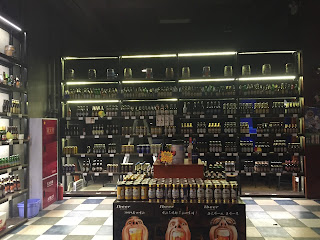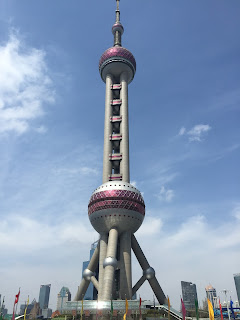It was one fine December evening and I just got
home from a 21-day solo travel around the Philippines. I must've caught the
travel bug because I was already browsing at international flights and what
caught my attention were the cheap round trip flights to China. With my credit
card in hand and my dad totally uninformed, I booked a flight going to Beijing.
I boarded a plane heading for Beijing on March
14, 2015. Four months in the making, twelve days of adventure. No turning back
now, I thought.
VISA
Traveling to China requires a visa. I sought
help from a travel agency and they gladly obliged. Their details are indicated
below.
WORLD WINGS - International Travel and Tours Corporation
G/F, K-Plaza, 18 Kamuning Nat'l Road, Quezon City
Telephone: (632)926-5804, 926-5806, 926-5817, 926-5821
Cellphone: +639178474660, +639228354322
Email: worldwingsintl@gmail.com
ACCOMMODATION
I spent little on accommodations since I
couchsurfed, wherein I stayed at places of locals on all the cities I stayed in
for FREE (see: couchsurfing.org for more details). Except for my last night in
Shanghai wherein I stayed in Blue Mountain Youth Hostel for a fee of 150 RMB
or 1101 PHP.
If you are not comfortable on the idea of
couchsurfing, there are lots of alternatives such as airbnb, agoda and
hostelworld. You'll be surprised by the abundance of budget backpacker hostels
in China.
TRANSPORTATION
 |
| The route of my China tour (Photo courtesy of Google Maps) |
For 12 days, I had been to four cities:
Beijing, Xi'an, Chengdu and Shanghai. They are MILES apart from each other. I traveled
between them by taking slow trains and a domestic flight. Slow trains are the
cheapest for long distance travel. In my case, rides took 12-14 hours!
In China, you can either buy train tickets at
the station or online. Tickets run out very FAST so I booked online (for a
small extra claiming fee). I got them at china-train-ticket.com to ensure my
seat before I arrive in China. Payment was via paypal and I claimed my tickets
at the Beijing West Railway station.
For my domestic flight from Chengdu to
Shanghai, I booked via qunar.com.
ITINERARY
My 12-day journey to Beijing, Xi’an, Chengdu
and Shanghai required planning because I want to visit as much sites as I can.
I will be making separate, detailed blog posts specific to each city. But for
now, I will be sharing you a summary of my awesome itinerary.
Day 1-3: Beijing
My first destination was none other than the
capital of China: Beijing (Bei means North and Jing means city or capital).
Most of the tourist spots are within the city center so everything can be
reached by city trains.
 |
| The Temple of Heaven |
 |
| At Tiananmen Square |
Beijing is PACKED with people in weekends. Prepare
yourself for long, chaotic queues especially when going to Tiananmen Square.
 |
| The long queue to Tiananmen Square |
I also visited the Great Wall of China! To get
there, I took a bus to the Badaling Section of the Wall. At the drop-off point,
you can take a cable car to climb up the wall. But I wanted to make my trip
extra special, I CLIMBED the wall by myself! The experience, let alone the
sights when climbing up steep stairs and walking along stone paths was amazing.
 |
| That's me on the Great Wall of China! |
 |
| Ming Tombs (yes, the red boxes are tombs containing the corpse of the emperor and some of his properties) |
 |
| Bird's nest stadium |
 |
| The Water Cube |
You can also find the Olympic Park at the city
center of Beijing. Inside the said park is the Bird’s Nest and the Water Cube,
both are venues of the 2008 Olympics. You may go inside these stadiums for an additional entrance fee.
 |
| At the Summer Palace |
You can indulge your taste buds at the famous
Hutong Street. This street is well known for a wide selection of food ranging
from Western to authentic Chinese delicacies.
 |
| My host Rita |
 |
| Dinner with Iiu Wei |
My stay in Beijing was more interesting thanks
to my host Rita who let me stay in her apartment. I also met up and had dinner
with Iiu Wei. Both are couchsurfers and travelers.
Day 4-6: Xi’an
One of the oldest and interesting cities in
China, the walled city of Xi’an is home to a lot of tourist destinations you
can go to. In this city, you can find the world-famous Terracotta Warriors.
Did you know that Xi’an was also the eastern end of the Silk Road? All my Asian
History lessons back in highschool and college came to life when I set foot in
this city!
 |
| Inside the Huaqing Hotspring Complex |
 |
| You cannot bathe in these hotsprings though, these are just the 'tubs' used by the Emperor back in Ancient China |
 |
| Terracotta Warriors |
 |
| The farmer who accidentally discovered the Warriors |
 |
| With my couchsurfer friend Jason |
I went to these destinations with Jason, a
fellow couchsurfer from Taiwan. It was so amazing how he knows a lot about
Chinese history which he gladly shares with me. It was like having a tour guide
and a travel buddy in one!
Although China is predominantly Buddhist, a
huge part of the population is Muslim, especially in Xi’an. They even have a
Moslem Street with a splendid mosque exhibiting an infusion of Chinese and
Muslim heritage. The Moslem Street also has lots of food stalls that reminded me of the Philippines. The sweets to the meat and even noodles are all Halal.
 |
| The Mosque at the Moslem Street |
 |
| A section of the Moslem Street |
 |
| Hand pulled noodles |
 |
| Enjoying noodles with my friend Dylan |
My guide along the Muslim Street and the
city center, Dylan, a couchsurfer and a traveller.
One can also find the bell and drum
tower inside the city center. These towers were used to tell time back in
Ancient China.
And of course, my stay in Xi’an won’t be
possible without my host, Jesper!
Day
7-9: Chengdu
My third city was Chengdu, the capital of
Sichuan Province. Marek, a Polish, was my host (Unfortunately, I did not have a
photo with him). This city is home to the Giant Panda Research Facility. Unfortunately,
I wasn’t able to visit the pandas because I arrived late and they don’t sell
admission tickets to latecomers. UNLUCKY ME.
From Chengdu, I took a high speed train going
to Leshan and saw the famous Leshan Buddha, the bigghest Buddha in China. This
Buddha is carved along the side of a mountain by monks hundreds, or even
thousands, of years ago. If you wanna go all Legends of the Hidden Temple, this
will take your breath away.
 |
| Stone carvings inside the Leshan Buddha complex |
 |
| The Leshan Giant Buddha |
 |
| My brother said I looked like Professor Snape in this photo |
The nightlife is also interesting in Chengdu as
you can go to the Jiuyanquiao Bar Street. Bars after bars are offering a wide range of
drinks. I found A LOT of beers, local and foreign. It was even my first time to see
a “beer library”.
Of course, a trip in Chengdu won’t be complete
without trying the famous Chengdu hotpot. For those unfamiliar of the food, it
is a bit similar to shabu-shabu but a thousand times more spicy!
Day 10-12: Shanghai
My last few days in the country was spent in
the modern city of Shanghai. Unlike the other cities, it’s easier to get around
here since more tourists and locals speak English. I was hosted by Nick, a
couchsurfer from the UK who now lives in Shanghai (I wasn’t able to take a
photo with him as well).
Even though Shanghai is a modern city, you can
also find some Chinese cultural sites such at the Yuyuan Gardens.
You may also see a lot of European influences
in China by going to The Bund. It is a waterfront in Shanghai with buildings
that would make you feel like you’re in Europe. Going there at night is highly
encouraged to see the wonderful city lights while enjoying the cool breeze by
the river.
 |
| The view on the other side of The Bund |
As my trip approaches its end, I made it a
point to ride the Maglev train going to the airport. Maglev, which is the short
term for magnetic levitation, are the fastest trains in the world with the
maglev train in Shanghai being the fastest commercial train running at
approximately 300 kilometers per hour!
BREAKDOWN OF EXPENSES
One Chinese Yuan or Remibi (RMB) has an
exchange rate of approximately 6-7 Philippine Pesos. You won’t have to worry
about expenses in China as the cost of living in the country is not as
expensive as Hong Kong or Singapore.
The table I am showing below are my major
expenses in China which are mostly food, transportation and entrance fees on
tourist spots. As I have mentioned, I did not spend that much on lodging since
I couchsurfed. I also prebooked some of my plane tickets that’s why some of my
expenses are expressed in US Dollars instead of Chinese RMB.
If you want to cut cost on some of the
expenses, I suggest you don’t pre-book the train tickets (to save up on booking
fees). You may also opt to go to the country-side or the not-so-mainstream
cities of China where the entrance fees (or even the hostels) would surely be
cheaper.
ACKNOWLEDGMENTS
Four cities, twelve days, thousands of
kilometers and countless times of getting lost, the #RenBondadChinaTour will
not be possible without the people who had helped me from preparations to my
actual trip. And with that, I would like to extend my sincerest gratitude to all
of them.
My dad and my family for all the financial and
moral support.
World Wings Tour for visa assistance.
My hosts: Rita (Beijing), Jesper (Xi’an), Marek
(Chengdu) and Nick (Shanghai).
My fellow couchsurfers: Iiu Wei, Dylan and
Jason.
And to all the people who helped me during the
times that I got lost and had to ask around for directions via translator or
even interpretative dance (lol).


























